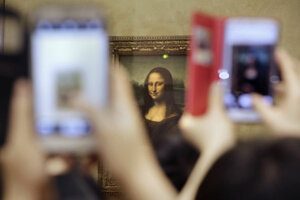Scientist says he found other paintings hidden beneath the 'Mona Lisa'
For hundreds of years the majority of public opinion is that 'Mona Lisa' is Lisa Gherardini, the wife of a silk merchant from Florence. New findings question that conclusion.

Tourist take pictures for Leonard de Vinci's La Joconde painting, Mona Lisa, at the Louvre museum in Paris, France, Thursday, Nov.19, 2015.
Amr Nabil/AP
A scientist who has spent more than a decade analyzing "Mona Lisa" now says he has found something – someone, in fact – behind her iconic smile.
Pascal Cotte says he has discovered two different artworks beneath the brushstrokes of Leonardo DaVinci’s masterpiece.
Mr. Cotte says in an interview with the BBC that his findings “shatter many myths and alter our vision of the painting forever.
"When I finished the reconstruction of Lisa Gherardini, I was in front of the portrait and she is totally different to 'Mona Lisa' today. This is not the same woman."
Since the painting was finished in 1517, there has been controversy over the subject of the Italian master’s most famous painting. For hundreds of years, though, the majority public opinion is that "Mona Lisa" is Lisa Gherardini, the wife of a silk merchant from Florence.
Cotte refutes that belief, saying the image he has been able to reconstruct beneath the painting’s surface is DaVinci’s actual "Mona Lisa," and that the portrait on top is of a different woman.
He claims there are two paintings under the portrait that Leonardo began in 1503. One is “a shadowy outline of a portrait with a larger head and nose, bigger hands but smaller lips,” the BBC reports, as well as a “Madonna-like” figure with a pearl headdress.
The "Mona Lisa" has come under scrutiny with increasing frequency over the last half century as technology has enabled further investigation of the work.
Cotte pointed multiple powerful lights on the painting, he tells the BBC, then used a camera to measure the lights' reflections. Using that data, Cotte says he reconstructed what occurred between each brushstroke and layer of paint.
He compares the process to peeling an onion “all the layers of the painting. We can reconstruct all the chronology of the creation of the painting."
Martin Kemp, Emeritus Professor of the History of Art at the University of Oxford says he doesn't buy Cotte’s story. Mr. Kemp tells the BBC that Cotte’s method only demonstrates what the artist “may have been thinking about.”
"I do not think there are these discrete stages which represent different portraits. I see it as more or less a continuous process of evolution. I am absolutely convinced that the 'Mona Lisa' is Lisa," he says.
The "Mona Lisa" is, of course, significant beyond her place as a tourist must-see in the Louvre that attracts millions each year. According to the Louvre, the portrait is the earliest Italian portrait to focus so closely on the subject, a balanced composition the museum calls “perfection” that led to similar works in Florence and Lombard throughout the 16th century.
The "Mona Lisa" brought forth new work from others, and proved innovative for Leonardo as well. According to the museum, “none of his earlier portraits display such controlled majesty.”


